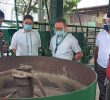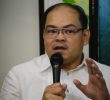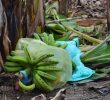DAVAO CITY – Ten foreign chambers have expressed interest in putting up investments and linkages here in the region, with the European chamber batting for interest in agriculture and biotechnology.
Many of the foreign chambers though were unable to attend the first Southern Mindanao Growth Corridor Investors Forum held Friday at Marco Polo Hotel.
The forum was jointly organized by the Mindanao offices of the American, Japanese and European chambers to drum up interest among foreign corporations to invest in Mindanao.
Ebb Hinchliffe , executive director of the American Chamber of Commerce of the Philippines (AmCham), made a pitch to investors to venture into the diverse fields of Southern Mindanao.
“You have everything from plantations, farms, mining, coastlines, and marine life,” he said.
Making connections
Hinchliffe added that Davao would also serve as one of the gateways for investments in the soon to be created Bangsamoro entity.
Hinchliffe’s enthusiasm was echoed by European Chamber of Commerce of the Philippines (ECCP) Vice President Martial Beck, who announced that the European Union has granted the establishment of the EU-Philippine business network, which he said would draw SMEs from United Kingdom, France, Germany, Italy, Spain, Belgium and Scandinavian countries to the Philippines.
“Our thrust is to make connections,” Beck explained.
He also said the chamber is planning to raise linkages between European and local academes for exchanges in technology.
Beck’s main pitch for European companies is investments in biotechnology in agriculture. In a previous press conference, he expressed interest to develop coco-water as a natural health drink. “Let’s go to the future in biotechnology,” he said.
The ECCP has around 700 members with 20 of them investing in Davao Region.
Agribusiness, ICT
Japanese Embassy First Secretar Ryutaro Aoki pointed out Japan’s long relations with Mindanao, and boasted Mindanao as the source of 90 percent of banana and pineapple imports into Japan.
Japan’s main investment in agribusiness is the Sumifru plantation which covers more than 11,000 hectares in the island, including Compostela Valley, Davao del Norte and Bukidnon.
Aoki noted that Mindanao has a strong youth market for their investments, as he also noted Davao region’s abundant mineral resources have enticed Japanese mining firms to come to the region.
Canadian Chamber of Commerce of the Philippines (CanCham) President Julian Payne said while their focus is on advocacy for mining, he would be pitching for investments in information technology (ICT) and business process outsourcing (BPOs), two of the top performing sectors in the region’s economy.
Payne said CanCham has 275 members with 28 of them investing in Davao region.
CanCham and ECCP also expressed interests to promote tourism, including the region’s coastal lines.
Other chambers who expressed interest include New Zealand, Finland, Australia and the Federation of Foreign Chambers of the Philippines. Event organizers said the heads of these chambers failed to arrive in Davao as flights were cancelled due to Typhoon Mario.
Horizontal growth
But their absence did not douse the enthusiasm of AmCham Davao President Philip Dizon, who sees the commitments from the chambers could spur the SMGC forum to meet once or twice a year.
Dizon, one of the leading businessman in the region’s agribusiness and eco-tourism, said the forum’s objective is to spur investments and growth horizontallyy to various cities in Southern Mindanao from General Santos City in neighboring Socsksargen region up to Mati, Davao Oriental.
“We can’t put all in Davao. General Santos have the ports so investments can go there,” Dizon said
He also stressed the region must expand beyond the agribusiness sector. One of his pitch is to draw investments into Philippine economic zone authority (PEZA) areas such as Hijo Estates and Anflocor in Tagum City, which offer port and transport facilities, and the Ciudades business-industrial-residential estate in Davao City.
Davao’s performance
The Mindanao Development Authority (MinDA) identified Southern Mindanao region and parts of Socsksargen region as Food, Agribusiness and Logistics Corridor with focus on agribusiness and mining.
The institution also said this cluster contributed 53% of Mindanao’s gross value in trade last year. Exports coming from Davao region also reported an increased by 31% in 2013 amounting to $ 1.99 billion, with the banana exports topping the exports with an amount of $877.1 million.
The SMGC is created by a joint agreement of the AmCham, ECCP and the Japan Chamber of Commerce in Mindanao to spur more investments into Mindanao.
The growth corridor is also part of the Davao Regional Development Plan (2014-2016) of the National Economic and Development Authority (NEDA), where its industrial road map focuses on the development of agro-processing industries and manufacturing sector.
The concept of the growth corridor was met with skepticism from think-tank Ibon Foundation, citing that experiences in other regions showed that foreign-led investments had not generate sustained growth and employment. (davaotoday.com)










